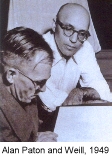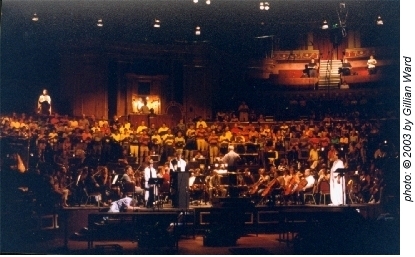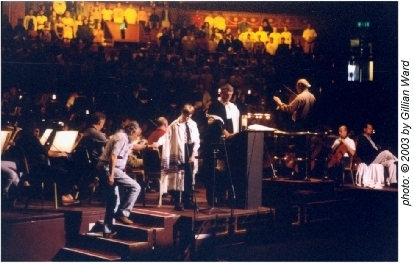|
|||||||||||||||||||||||||||||||||||||||||
|
Home
| Kurt
Weill | Drew's books on Kurt Weill |
Drew's Weill
Editions: 1. Concert and Radio Works | |
|||||||||||||||||||||||||||||||||||||||||
|
NB - Performance rights and Rentals: the term 'etc' following 'UK' in the definitions of territories corresponds to BREV in the current edition of Kurt Weill - A Guide To His Works (Kurt Weill Foundation) where it is defined as "Countries of the former British Commonwealth [sic], including Australia, New Zealand, Israel, etc. [sic]. 3. CONCERT EXCERPTS FROM STAGE WORKS - requiring simple or minimal staging Most of these arrangements came about in response to the specific requirements of performing organisations in a particular context; all were intended in the longer term to enlarge the rather limited repertory of music by Weill that was available for non-theatrical orchestras or ensembles, with or without vocal solos and choruses. No form of competition with the original stage works was intended or implied. Except in Propheten, singers do not appear as named characters, and story-telling and plot-outlines are implicit (if at all) in the juxtaposition and overall sequence of discrete musical forms and the lyrics embodied in them. Minimal staging is defined as dramatically significant exits, entrances, and gestures, plus simple lighting; semi-staging adds dialogue-direction and movement (including travel-spots) as essentials, video adjuncts as desirable. Concert sequence from Maxwell Anderson's and Kurt Weill's 'Musical Tragedy' Lost in the Stars (1949); spoken texts from Alan Paton's novel Cry, the Beloved Country. Commissioned by the American Symphony Orchestra (1988) Voices and instrumentation:
Duration: 35 minutes' music Performance Materials: USA: Rogers and Hammerstein; UK 'etc', SCAN: Josef Weinberger First performance: Many possibilities for lighting, titling, film-clips or projections, and a simple staging of the double choruses Containing all Weill's settings of Brecht's lyrics for the gangster-play by Elisabeth Hauptmann, the original concert-version was prepared in 1975 for the first of the London Sinfonietta's Berlin Festival concerts at the Academy of Arts; and it was then included in the same artists' three-LP album for Deutsche Grammophon (where it was deprived of the intended 'encore', the Bilbao Song). The order of numbers in this widely-performed concert version has been published in early editions of the Kurt Weill Foundation's Guide, but has now been superseded. The altogether more effective ordering listed below was prepared for, and first performed at, the London Sinfonietta's Weill-Centenary programme at the Queen Elizabeth Hall in October 1999. 'Songspiel' remains a useful description by analogy with the 'little' Mahagonny. With no dialogue, characters, or dramatic action, the 'Songspiel' becomes a 'playful' song-sequence, and emphatically not a Lieder-cycle with instrumental ensemble. Concert performance in the 'classical' manner is unthinkable; performing organisations should allow rehearsal-time for simple stage-direction and lighting, and sensitive solution of the balance problems whenever band and singers are on the same platform. While the chorus may make a point of singing from hymn-sheets, the soloists should know their parts well enough to be relatively independent of their scores and music-stands. Voices and instrumentation:
Prologue - Memories and
Renovations 1. Hellfire and Repentance
2. Youth and Experience
3. Poverty and Riches
Epilogue - Benedictions
Duration: 35 minutes Performance materials: USA, UK 'etc': European American Music Corporation. All other territories: Universal Edition Recording: DGG 2740 153 (Mary Thomas, Meriel Dickinson, Philip Langridge, Ian Partridge, Benjamin Luxon; The London Sinfonietta, c. David Atherton) Propheten combines the hitherto unperformed or fragmented music for the fourth act of the biblical/contemporary epic Der Weg der Verheißung by Franz Werfel with a visionary recollection of the Act 3 finale and its celebration of the dedication of the Temple of King Solomon. Apart from some short but important passages of unaccompanied dialogue, it is a continuous musical structure. Precisely because that continuity incorporates the spoken word, the dialogue is reduced to an indispensable minimum, and is to be spoken with due regard for the tempo and texture of the music that frames it. However well-intentioned, additions to the dialogue in the interests of heightening the 'drama' or, with hindsight, underlining the Holocaust message, not only weaken the concert form - basically that of a popular oratorio in the tradition of Honegger's King David - but also inadvertently enter into competition with the authentic stage version: precisely what Propheten (like its predecessor, Cry, the Beloved Country) was designed to avoid. Commissioned by the BBC Proms for the 1998 season but first performed, by prior arrangement, in Vienna, Propheten (Prophets) encapsulates the story of the 'true prophet' Jeremiah and his struggle with the 'false prophet' Hananiah. Vacillating between the two is King Zedekiah.
Voices and
instrumentation: Singing roles from the chorus: Der Widersprecher (baritone), Ein Knabe (boy soprano), Eine Frau (mezzo), Weisse Engel 2 (soprano), Dunkle Engel (baritone), Rahel (soprano), large choir, divisible into two parts, with optional children's choir Speaking roles: Der Dreizehnjährige, Der Entfremdete, Zedekiah, Pashur, Ebed Melech, Der Wächter, Der Bote des Königs Instrumentation: 2 flutes/picc, oboe, 2 clarinets/E-flat clar; bassoon; 4 horns, 3 trumpets, 3 trombones, tuba; percussion, timps, harp, 2 pianos, organ, strings The main sections are listed below. Apart from the orchestral prelude and the spoken prologue (with interpolated fugatos), each of the sections has several sub-sections and the last one, 'A Vision of Temples' is a large-scale finale. Prelude for orchestra: (Hatikvah - 'To Hope') Prologue: House of Prayer (Fugatos I-IV)
Epilogue: In the House of Prayer Duration: 45 minutes Performance materials: European American Music Corporation
A projected version of Weill's 1939 score for Railroads on Parade. Der
Silbersee There are no current licensing-arrangements for this version, which was prepared for a semi-staged and televised concert performance conducted by Gary Bertini at the 1971 Holland Festival, in a double-bill with Weill's Royal Palace. Its primary function was to provide an opportunity for hearing the score complete and in its original orchestration for the first time since 1933 of hearing the score complete and in its original orchestration. See Concert Suites for Silbersee-Gesänge Voices and
instrumentation: Duration: 70 minutes Publisher: vocal score Universal Edition 10464 Song-sequence from Johnny Johnson, for two singers with small amateur chorus and instrumental ensemble. Johnny Johnson - Paul Green's and Weill's musical play for the Group Theatre (1936) - was Weill's first score for the American stage, and musically is the only one within the scope of small ensembles. The original War Play sequence of 25 numbers drawn from the World War 1 scenes of Johnny Johnson, was devised in consultation with Paul Green, and was intended specifically for the London Sinfonietta's 'War and Peace' programme at the Berlin Festival in September 1975. In the aftermath of that event, however, there were further performances in Germany, Belgium, and the Netherlands. In 1988, Richard Pittman conducted the United States premiere with his ensemble in Boston. Despite some essential adjustments and excisions and one notable improvement, the version of War Play presented at the 1990 Almeida Festival (and televised by the BBC) still seemed overloaded by the documentary and narrative elements that related specifically to the context of Berlin in 1975. Having advised against a further revival during London's Weill centenary celebrations, Drew prepared a shorter and much simpler version - an expediency that proved unacceptable to the conductor and is no longer relevant. The political and other consequences of the destruction of the World Trade Centre on 11 September 2001 have removed whatever intellectual, 'artistic' or practical justification there may once have been for performing the War Play sequence in anything resembling its original form. 'Songs from a War Play' is the working title (2002) for a new and unadorned concert-sequence, incorporating most of the numbers previously listed under War Play, but adding others that have no direct connections with the themes of war and peace. Minimal staging, identical in principle with the requirements for the Happy End Songspiel. |
|||||||||||||||||||||||||||||||||||||||||
|
|||||||||||||||||||||||||||||||||||||||||
|
Material Copyright © 2002 David Drew. |
|||||||||||||||||||||||||||||||||||||||||


